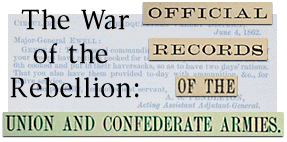Summary:
Union General Phil Sheridan writes General Grant in February, 1865, to inform him
of the situation in the Shenandoah Valley, including movements in the Staunton
area.
Lieut.-Gen. GRANT:
WINCHESTER,
February 8, 1865
Your dispatch of to-day received. I feel very certain of being able to break the Central railroad and the canal as soon as the weather will permit. At present we have twelve inches of snow on the ground, and have had snow on the ground since the 10th of last December, with extremely cold weather. All the late expeditions to break up guerrilla bands have had many men frost-bitten. The following is my latest information as to the movements of the enemy; this information I have had through different scourges for the last ten days: Two divisions of the troops from the Valley were encamped on the road from Petersburg to Richmond; the other division was in the trenches, having taken the place of a division sent south, said to be Kershaw's. Wharton's division, from 3,000 to 4,000 strong, was on the railroad, near Fisherville, between Staunton and Waynesborough. Lomax's cavalry moved from the east side of the Blue Ridge to the Valley, and thence to Warm Springs, scattered through the numerous little valleys in the vicinity of Harrisonburg. Rosser sent Wickham's brigade to the east side of Blue Ridge; his own (Rosser's) brigade was six miles west of Staunton. Payne's brigade was near Lexington. Two horse batteries were disbanded and pieces sent to Waynesborough or Richmond. There was considerable artillery in the upper Valley in the vicinity of Lynchburg. This artillery belonged to the infantry division sent by Early to Richmond, as these divisions I know did not take their batteries with them. It has been reported to me within a day or two that one brigade of Wharton's division had left for Dublin Station; probably it went to Richmond. The foregoing information was obtained from a man that I sent to Richmond; also from my scouts sent to Staunton. Since then I have sent down to burn the bridge at Lynchburg. There has been the report here, and it has undoubtedly reached the rebels, that there was to be a big cavalry raid sent out from this point. This report was brought here from Washington, where it originated. It may have caused this movement of artillery by the rebels.
P. H. SHERIDAN,
Maj.-Gen.
Bibliographic Information : Letter Reproduced from The War of The Rebellion: Official Records of the Union and Confederate Armies, Series 1, Volume 46, Serial No. 96, Pages 496, Broadfoot Publishing Company, Wilmington, NC, 1997.

